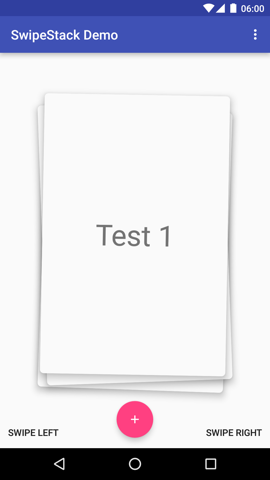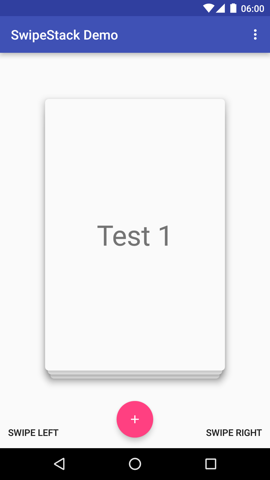SwipeStack alternatives and similar packages
Based on the "Other Widget" category.
Alternatively, view SwipeStack alternatives based on common mentions on social networks and blogs.
-
AndroidSlidingUpPanel
This library provides a simple way to add a draggable sliding up panel (popularized by Google Music and Google Maps) to your Android application. Brought to you by Umano. -
BottomBar
(Deprecated) A custom view component that mimics the new Material Design Bottom Navigation pattern. -
ShortcutBadger
An Android library supports badge notification like iOS in Samsung, LG, Sony and HTC launchers. -
SystemBarTint
[DEPRECATED] Apply background tinting to the Android system UI when using KitKat translucent modes -
TapTargetView
An implementation of tap targets from the Material Design guidelines for feature discovery. -
android-viewbadger
[DEPRECATED] A simple way to "badge" any given Android view at runtime without having to cater for it in layout -
android-iconify
Android integration of multiple icon providers such as FontAwesome, Entypo, Typicons,... -
android-stackblur
Android StackBlur is a library that can perform a blurry effect on a Bitmap based on a gradient or radius, and return the result. The library is based on the code of Mario Klingemann. -
DraggablePanel
DISCONTINUED. Android library used to create an awesome Android UI based on a draggable element similar to the last YouTube graphic component. -
aFileChooser
DISCONTINUED. [DEPRECATED] Android library that provides a file explorer to let users select files on external storage. -
Swipecards
A Tinder-like Android library to create the swipe cards effect. You can swipe left or right to like or dislike the content. -
TourGuide
TourGuide is an Android library that aims to provide an easy way to add pointers with animations over a desired Android View -
StickyGridHeaders
DISCONTINUED. An Android Library that makes it easy to make grid views with sectioned data and headers that stick to the top. -
FloatingView
FloatingView can make the target view floating above the anchor view with cool animation -
TileView
TileView is a subclass of android.view.ViewGroup that asynchronously displays, pans and zooms tile-based images. Plugins are available for features like markers, hotspots, and path drawing. -
Bubbles for Android
Bubbles for Android is an Android library to provide chat heads capabilities on your apps. With a fast way to integrate with your development. -
Android-ActionItemBadge
This library offers a simple method to add a small badge icon to your ActionBar-MenuItem -
RippleView
View that imitates Ripple Effect on click which was introduced in Android L (for Android 2.3+) -
android-sliding-layer-lib
DISCONTINUED. Highly customizable SlidingLayer as you have seen in Wunderlist -
SortableTableView
An Android library containing a simple TableView and an advanced SortableTableView providing a lot of customisation possibilities to fit all needs. -
ScratchView
ScratchView repo is UX Design involving scratch cards like views which are scratched to reveal the information they conceal. -
FabricView
A new canvas drawing library for Android. Aims to be the Fabric.js for Android. Supports text, images, and hand/stylus drawing input. The library has a website and API docs, check it out
InfluxDB - Power Real-Time Data Analytics at Scale

* Code Quality Rankings and insights are calculated and provided by Lumnify.
They vary from L1 to L5 with "L5" being the highest.
Do you think we are missing an alternative of SwipeStack or a related project?
README
SwipeStack
A simple, customizable and easy to use swipeable view stack for Android.



QuickStart
Include the Gradle dependency
dependencies {
compile 'link.fls:swipestack:0.3.0'
}
Use it in your layout file
- Use the
link.fls.swipestack.SwipeStackview in your XML layout file - Set the parent view's
clipChildrenattribute tofalse
Example:
<?xml version="1.0" encoding="utf-8"?>
<FrameLayout
xmlns:android="http://schemas.android.com/apk/res/android"
xmlns:app="http://schemas.android.com/apk/res-auto"
android:layout_width="match_parent"
android:layout_height="match_parent"
android:clipChildren="false">
<link.fls.swipestack.SwipeStack
android:id="@+id/swipeStack"
android:layout_width="320dp"
android:layout_height="240dp"
android:padding="32dp"/>
</FrameLayout>
Create an adapter
Create an adapter which holds the data and creates the views for the stack.
Example:
public class SwipeStackAdapter extends BaseAdapter {
private List<String> mData;
public SwipeStackAdapter(List<String> data) {
this.mData = data;
}
@Override
public int getCount() {
return mData.size();
}
@Override
public String getItem(int position) {
return mData.get(position);
}
@Override
public long getItemId(int position) {
return position;
}
@Override
public View getView(final int position, View convertView, ViewGroup parent) {
convertView = getLayoutInflater().inflate(R.layout.card, parent, false);
TextView textViewCard = (TextView) convertView.findViewById(R.id.textViewCard);
textViewCard.setText(mData.get(position));
return convertView;
}
}
Assign the adapter to the SwipeStack
Last, but not least, assign the adapter to the SwipeStack.
Example:
SwipeStack swipeStack = (SwipeStack) findViewById(R.id.swipeStack);
swipeStack.setAdapter(new SwipeStackAdapter(mData));
That's it!
Callbacks
Currently SwipeStack implements the following callbacks:
- the
SwipeStackListenernotifies you when a view was swiped to the left / right or when the stack becomes empty. - the
SwipeProgressListenernotifies you about the progress when the user starts / stops dragging a view around.
Attributes
All attributes are optional.
allowed_swipe_directions specifies the allowed swipe directions. Default: both
animation_duration specifies the duration of the animations. Default: 300ms
stack_size specifies the maximum number of visible views. Default: 3
stack_spacing specifies the vertical distance between two views. Default: 12dp
stack_rotation specifies the maximum random ratation (in degrees) of a card on the stack. Default: 8
swipe_rotation specifies the rotation (in degrees) of the view when it gets swiped left / right. Default: 15
swipe_opacity specifies the opacity of the view when it gets swiped left / right. Default: 1.0
scale_factor specifies the scale factor of the views in the stack. Default: 1.0
disable_hw_acceleration set to true disables hardware acceleration. Default: false
Copyright Notice
Copyright (C) 2016 Frederik Schweiger
Licensed under the Apache License, Version 2.0 (the "License");
you may not use this file except in compliance with the License.
You may obtain a copy of the License at
http://www.apache.org/licenses/LICENSE-2.0
Unless required by applicable law or agreed to in writing, software
distributed under the License is distributed on an "AS IS" BASIS,
WITHOUT WARRANTIES OR CONDITIONS OF ANY KIND, either express or implied.
See the License for the specific language governing permissions and
limitations under the License.
*Note that all licence references and agreements mentioned in the SwipeStack README section above
are relevant to that project's source code only.




